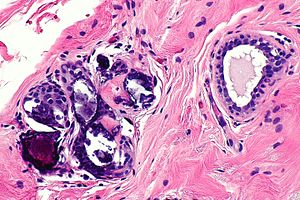Breast calcifications
(Redirected from Breast calcs)
Jump to navigation
Jump to search

Calcification in benign breast tissue. H&E stain. (WC/Nephron)
Breast calcifications may be found in benign or malignant breast specimens.
General
- Abnormal breast calcifications are considered a marker of malignancy.
- Radiologists can pick-up calcifications that are approximately 100 micrometers; if "calcs" is on the requisition, the pathologist should be finding calcifications this size.[1]
- The large calcifications seen on radiology are approximately 1/5 - 1/6 the size of a HPF, if the field of view (FOV) is ~0.55 mm (as is the case with 22 mm-10x eye pieces and a 40x objective).
Types:
- Calcium phosphate - typically purple.
- Q. How to remember? A. Purple = Phosphate.
- Calcium oxalate - not associated with malignancy.[2]
Microscopic
Features of calcification:
- Purple globs (with concentric rings) on H&E - represent calcium phosphate.
- Often in the lumen of a gland, may be in the stroma.
- Calcific material typically has a well-demarcated border +/- "sharp corners".
Note:
- Calcium oxalate - visible with (light) polarization.


